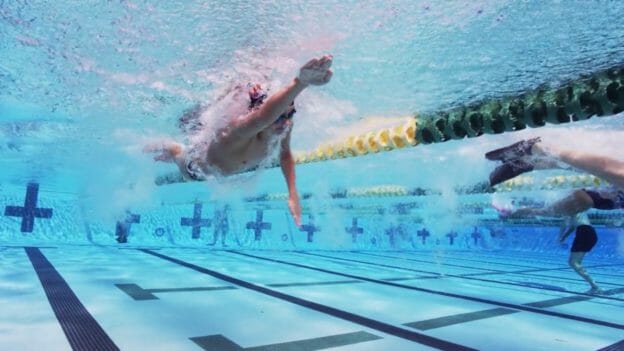Where is the Propulsion greatest during the underwater Freestyle Pull?
I have asked this question for years to some of the most successful coaches and swimmers I know. The answers I have heard are variable. The pulling arm begins to generate propulsion (forces that move the swimmer forward) when the hand is about one foot in front of the shoulder and can continue generating propulsion until the arm runs out of length. Some believe the greatest pulling force is in the front quadrant (in front of the shoulder). Others think the propulsion is greatest in the back quadrant. Still others believe the peak propulsion occurs right at the shoulder, as the hand passes from the front to the back quadrant. Until I had the technology available to measure the forces on the pulling hand (Pressure Meter), I didn’t know the answer, either.
From a purely biomechanical standpoint, it would seem logical that the pulling arm is in its strongest position somewhere near the shoulder, as the hand is moving backwards. As the hand moves through its somewhat circuitous underwater pathway, the arm goes from a negative angle in the shoulder joint to a more neutral or even a slightly positive angle. Those are positions of greater strength. At its midway point near the shoulder, several large and important muscles pull the arm through the water, whether using a high-elbow or deep pulling motion. As the hand nears the end of the propulsion phase in the back quadrant, the Triceps muscles are about the only remaining ones still working, extending the forearm. To determine the strongest point in that pulling path, however, there is more to the answer than just understanding the biomechanics
Another important factor is the coupling energy of the recovering arm, the shoulder rotation and the hip rotation. The kinetic energy of the recovering arm and rotating shoulder usually peak simultaneously, while the hip rotational energy peaks about .2 seconds later. Depending on where the swimmer elects to place more effort, in the rotating shoulder or in the rotating hip, the point of greatest pulling propulsion is affected. Swimmers tend to pull (or push) harder when they concurrently reach the peak angular velocity of either of these two motions. In other words, swimmers have the option of putting more effort into the front quadrant or mid-point of the pull, using strong shoulder rotation, or into the back quadrant of the pull, by pushing harder out the back and by rotating their hip aggressively.
The correct answer to the question is all of the above, depending on the swimmer and the technique that he or she is using. Below are three good examples of where the peak propulsion of the hand occurs in the front quadrant, at the shoulder and in the back quadrant.
Zane Grothe reaches his peak pressure (green curve above at yellow line) on the left hand in the front quadrant using a hybrid technique (breathing right). The first green peak is the highest pressure achieved during the propulsion phases. The final green peak occurs during his hand release phase.
With the right hand, Zane reaches his peak hand pressure (orange graph above) very near his shoulder. With both hands, Zane’s peak propulsion occurs nearly simultaneously with the peak shoulder rotation (first peak in pink graph below). The second orange peak above occurs during his hand release phase.
Elite freestyler Anika Delgado uses a slower stroke rate to maximize her pulling power by pressing hard out the back with a strong hip rotation. The peak pressure from her right hand (orange graph above at yellow line) occurs in the back quadrant at the very end of her propulsion phase, while she is still pressing backwards.
While the peak pressures or forces of the pulling arms are important, what is more important is the average pressure maintained throughout the entire propulsion phases of the pull. That determines how well a swimmer is holding water through the most important part of the pull. Another term that defines this ability of the swimmer is called the impulse of the pulling force, which is the integral or area under the propulsion pressure or force curve.
I sometimes hear the terms power and propulsion used interchangeably. They are related, but they are not the same. With a rotating arm, power refers to the multiple of the force (torque) and the angular velocity of the pulling arm. Power can also be defined as the amount of work done over a unit of time. A powerful swimmer is one who can sustain a higher pulling pressure throughout the propulsion phases (front and back quadrant). That is the unit of time that matters.
Those two phases together range from about .35 seconds with a fast, shoulder-driven freestyle technique to over .5 seconds in slower, hip-driven freestyle technique. So often, we find with the pressure meter studies that swimmers slip or let go of the water with their hands, losing propulsion and power in the process.
To become a more powerful swimmer, do what Aaron Piersol used to say, grip it and rip it! Keep good pressure on the water with your hands during the pull and don’t let go. To learn more about the six phases of the freestyle pulling cycle, read our book Fundamentals of Fast Swimming.
Yours in Swimming,
Gary Sr.

